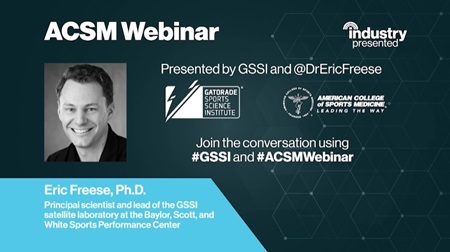View the webinar One CEC available here

Q: How are we conceptualizing “readiness” in this context?
Readiness can have a variety of meanings, but in the context of athletic readiness, it’s the return to psychophysiological homeostasis that enables an athlete to train or compete at a set level. However, that “set level” may be defined differently depending on the time of the year: is it off-season where you’re more willing to accept higher levels of fatigue, or is it a competitive season where elite performance is the goal? Context is very important here.
Q: Outside of a team setting, what tools do you recommend individual athletes use beyond perceptual measures? For example, are there specific HRR products that are effective?
This is highly dependent on the sport, but across a variety of individual sports, heart rate indices, including exercise heart rate and heart rate recovery, are validated methods to monitor internal load. The importance in identifying a validated product, whether worn on the wrist or chest, is extremely important. As far as monitoring external load, GPS and power-based devices for capturing external load metrics are effective monitoring tools.
Q: The number of wellness roles has significantly increased over the years, including in the athletic world. As you mentioned, the internal load is critical to understanding overall load. My question is whether you see a wellness role to be the future of athletics where they consider the multiple variables that can impact performance.
Absolutely. We’re already starting to see an uptick in sport psychologist roles in elite sport, and I believe that will only continue to grow as athlete health and wellness grows beyond the physical attributes and capabilities.
Q: How often do you measure internal load? Is there a particular tool you use to measure this?
This depends on the sport, athlete and organization. The frequency at which you measure is dependent on how you plan to apply this information in the athletic setting and the ability for you to capture that information. Internal load measures such as sRPE may be easier to capture on a daily basis rather than biomarkers such as testosterone or cortisol, given the burden on the athlete and the cost of analyses. Daily monitoring of exercise heart rate can be a great tool at measuring daily internal load responses; however, there are a number of other useful tools.
Q: Which monitoring tools would you suggest for power-oriented athletes?
Monitoring external load through standard rep schematics or bar speed during lifting sessions while utilizing force output during the recovery period can be a useful tool to monitor the internal load response to specific training blocks, and subjective assessments can be used for daily load monitoring.
Q: What is your approach when there is a discrepancy between internal and external loading?
First, it’s understanding if the abnormal internal load response is correct, such as identifying any potential errors in data acquisition and analysis. Then it’s identifying if that response would be expected due to a potential uptick in training volume (i.e., external load). If there is still a discrepancy, this gives the coach/practitioner the opportunity to flag this to the athlete and understand if there are any external issues that may be a reason for this response, such as poor sleep, poor diet/hydration, or external stressors (think college students going through finals). Then it’s up to the coach and staff to identify the best course of action, whether that’s a decrease in prescribed training load or other behavior modifications such as diet interventions.
Q: What is your opinion on CPK as a biomarker for internal load monitoring?
There are a variety of biomarkers that may be useful in monitoring internal load in athletes. Testosterone and cortisol have an extensive literature base to understand muscle status and the internal load response to training stimuli, including during athletic seasons. CK is a useful marker for monitoring muscle damage as well. I suggest looking at the brief review published by Lee et al. (2017) (PMID: 28737585).
Q: Regarding perceptual assessments, how do you approach an athlete with poor results? What changes will you do according to the results? How long prior to training do they fill out the form?
This depends on the perceptual assessment. Wellness questionnaires should be administered upon waking, preferably prior to any daily stressors such as training. sRPE should be administered following training. It’s always easiest to assess immediately after as the athlete is on-site and fresh; however, this scale can be validly utilized up to 24 hours post training. It’s imperative to utilize this data in the context of the entire athlete-monitoring program, including understanding their external load, to determine whether any abnormal results are prescriptive in nature (i.e., high training demands for adaptations) or whether an abnormal result is due to poor training status which requires further intervention.
Q: If we only have heart rate monitoring, recording, to measure “readiness” what are the red flags of HR response during exercise sessions (max and recovery time) and daily/morning resting HR?
This is highly specific to the individual as max heart rate and heart rate recovery times vary athlete to athlete. It’s important to have a baseline understanding of the athlete’s typical physiological response to training to better interpret any internal load responses to training.
Q: Universities, such as the University of Washington athletics department, have a wellness coordinator on staff who looks out for their players’ well-being. Perhaps that is the answer to relieving that responsibility on other practitioners, such as S&C, R.D., and athletic trainers?
I think this is fantastic, and the more experts practitioners can rely on also helps build a level of trust with the athlete that they are doing what is best for them.